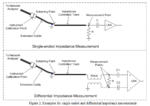Zeppelin
Member level 1

Hi all,
I am looking for a reliable way to measure return loss between two pads on my pcb.
Does soldering a piece of coax feed line give me reliable results?
Are there any considerations e.g. length?
Thank you
I am looking for a reliable way to measure return loss between two pads on my pcb.
Does soldering a piece of coax feed line give me reliable results?
Are there any considerations e.g. length?
Thank you




